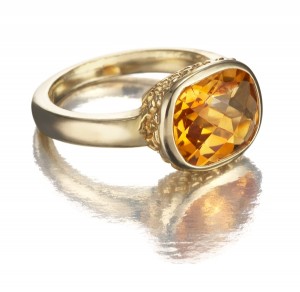
There is wisdom in the grandmotherly advice that jewelry “should be the last thing you put on and the first thing you take off”. To protect your jewelry and everything from diamonds and pearls to opals and emeralds, it is important to be gentle with your pieces to ensure a lifetime of enjoyment. Read on for a few tips on how to care for your jewelry.
DO
- Do bring your everyday pieces of jewelry into your local jeweler at least once a year to have them checked and cleaned
Just as we have our tires rotated and add gas to our cars, there is maintenance required for most jewelry that is worn daily. Metals used in jewelry are generally strong and durable, but they can still be dented and scratched over time by door handles, weights and general daily contact. Remembering to have your jewelry checked annually will help catch any issues (missing prongs, broken stones, weak shanks, etc.) before they result in broken pieces or missing stones. At this time, jewelry can also be cleaned of the deposits of skin, oil and lotions that accumulate over time.
- Do remove your jewelry before you go to bed
Chains can get caught and kinked while you sleep and earrings can cause irritation. Most importantly, our bodies swell throughout the day; some people wake with swollen joints and others have joints that swell by the end of each evening. For comfort and safety, it is recommended to remove all jewelry while you sleep.
- Do remove your jewelry before you work in the garden or lift weights at the gym
Countless rings and diamonds have been lost in flowerbeds while their owners gardened. Rings have been smashed by free weights at gyms and fingers have been broken during basketball games only to require the wedding band to be cut off in the emergency room. Please remove your jewelry to keep your hands safe and your jewelry protected while you’re doing potentially vigorous activity.
- Do use a soft toothbrush with jewelry cleaner or warm water to periodically clean most of your jewelry
If you do not have jewelry cleaner, you can use a few drops of detergent mixed with warm water as a substitute. Make sure you clean the jewelry on a countertop away from the sink and rinse with warm water only when you have a grate over the drain. Dry on a soft cloth. This will help remove deposits on your gold, platinum and gemstone jewelry. (Caution: only specific types of jewelry should be cleaned in this way, see below.)
- Do keep your silver polished!
Regular wear of silver pieces will keep them shiny and polished because of the friction from wear as well as the oil from your skin.

You can pick up an inexpensive jeweler’s polishing cloth at your local jeweler to polish silver pieces that have tarnished over time. Be aware that these cloths contain a polishing compound, so should wash your hands when you are finished polishing.
- Do have your jeweler re-string your pearls!
Expect to have it done every one to three years depending on how often the pearls are worn.
- Do remember that the gemstones in your jewelry are not indestructible
Gemstones vary greatly in hardness but nearly all can be scratched by everyday use. Even diamonds, when hit just right against a countertop or dropped from a height, can break apart. Enough pressure against a gemstone can shatter the stone. Be aware that gemstones, especially those worn in rings, will become worn and abraded over time from everyday use. Check with your local jeweler to see if it’s possible to have old stones re-polished.
DO NOT
- Do not wear your jewelry at the pool
Not only does the chlorinated water take its toll on your hair and skin, it can also damage your gold and platinum jewelry over time. Not to mention the potential horror of realizing your ring has fallen off your finger during your day at the pool!
- Do not have your jewelry fully refinished by your jeweler more than once a year
Refinishing means the ring or piece of jewelry will be surgically cleaned, all scratches will be filed out and the piece will be fully polished to look “like new” again. The filing and polishing removes microscopic layers of metal to smooth the surface. Having this process done once a year is safe, but several times a year will unnecessarily remove metal from your piece and shorten its life in the long run.
- Do not have your white gold rings rhodium plated more than once a year
A good jeweler will fully polish and refinish the jewelry before rhodium plating, and as explained above, this is not something that should be done more than once a year.
- Do not wrap a rubber band around any silver jewelry
The rubber will react with the silver, breakdown and leave stains on the metal.
- Do not hurt yourself removing a ring that has grown too small around your finger
If your finger has swollen or expanded over time and you are unable to get your ring off, call on your local jeweler. Provided they have a ring cutter, the jeweler will be able to safely cut it off of you without causing injury. Once the ring has been removed, it is generally recommended to wait two weeks to let the finger regain its natural shape. Once the finger has returned to normal, your jeweler can measure your finger for the proper size and repair the cut band to the new size.

- Do not try to clean your own opals, coral, pearls, turquoise or amber!
These are all porous materials and can potentially absorb any oils or cleaning products used while wearing them. A trusted jeweler will be able to safely clean these items without damaging their integrity.
Following these simple tips will keep you and your jewelry happy for many years. When in doubt, bring your jewelry to your local jeweler and ask them whatever questions you may have. Be gentle with your jewelry, keep it in a secure and dry location and you’ll have beautiful pieces for decades to come.
If you are new to an area or are trying to find a local jeweler, try searching through the American Gemological Society’s resources. Their site will help you locate certified jewelers via your state, zip code or local area.
Read more tips on gemstone maintenance.
